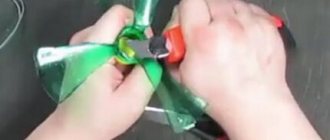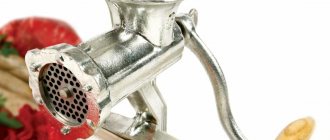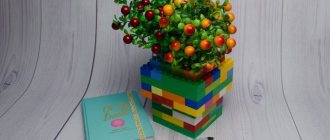Hydrochloric acid is used in the manufacture of some explosives. Now it is a recursor, and you won’t be able to purchase it in Himmag. But it is quite easy to make at home. Chemically pure concentrated hydrochloric acid is a colorless liquid that fumes in air (hydrogen chloride is released) with a pungent odor. The density of hydrochloric acid is 1.19, at a concentration of 37%.
Reagents:
NaCl – table salt. In principle, any chloride will do, KCl for example.
H2SO4 – sulfuric acid. It must be concentrated (chars the match when cold), evaporated electrolyte is quite suitable.
Protective equipment:
Hydrochloric acid is EVIL! Causes chemical burns upon contact with skin. It shouldn't get on your clothes either - it corrodes instantly. Hydrogen chloride is poisonous! It is better to produce hydrochloric acid outdoors or in a well-ventilated area. Minimum protective equipment: 1. Rubber gloves (preferably as in the photo). 2. A gas mask or respirator (will help you quickly eliminate the consequences of a possible accident without harm to health).
Equipment: 1. Electric stove or other heat source. 2. Libra. 3. Measuring cup. 4. Reaction vessel, I used a 250 ml flat bottom flask. 5. Safety bottle. Any flask will work perfectly (the main thing is that the volume of the flask is not less than the volume of the acid produced). 6. A pair of rubber plugs. 7. Tubes, you can use tubes from IVs.
The result should be a device like this.
True, there are a couple of nuances here: 1. The tubes used in the device must be of the same diameter; it is better to avoid using syringe needles as fittings. This will create a pressure difference and the device will explode (this happened to me when using a syringe needle). 2. It is better not to immerse the tube from which HCl comes into water, since water can be sucked into the system due to the high solubility of HCl. 3. The safety flask is, in principle, optional, you can do without it, but if water is sucked into the reaction flask and it may burst, spraying hot sulfuric acid.
Manufacturing:
1. Weigh out about 10-20 grams of salt. Take about the same amount of acid, 10-15 milliliters. I wrote approximately because the amount of acid depends on its concentration. I took 1:1 by volume. If the acid is 60-80%, then hydrogen chloride will first dissolve in water, and only then will it be released.
In short, LESS WATER – LESS PROBLEMS! So it is better to spend more time evaporating the electrolyte.
2. Place the salt in the reaction flask. 3. We assemble the installation, check all connections, they must be tight. 4. Pour 50-100 ml into a measuring cup. water (preferably distilled) and insert a tube into it. 5. We put on a gas mask. 6. Now the main thing is to quickly pour sulfuric acid into the reaction flask and plug the neck with a gas outlet tube. A gas mask will save you from the hydrogen chloride that will begin to be released. 7. At first the reaction occurs on its own, then the flask needs to be heated a little. NaCl + H2SO4 → Na2SO4 + 2HCl↑
The following are photographs of the device and the entire process:
In this way you can obtain acid with a maximum concentration of 37-40%. During the receiving process, you will see how the volume of water that you poured into the glass begins to increase. Continue saturating the water until the gas no longer dissolves. The acid should be stored in a tightly closed container to avoid volatilization of HCl. GOOD LUCK!
Source vzrivpaket.ru
Making acid at home
Let's try to make alkali or acid at home using improvised means.
Of course, the preparation we receive will not be concentrated (this is achieved using special equipment), but the characteristic properties of the acid will certainly be noticeable. The easiest way to obtain acid at home
will be based on the electrolysis of some solution, which dissociates to form a sulfate ion. It is also possible to obtain acid in another way, but this involves either obtaining sulfur dioxide or other chemicals that may not be available, and all of them are dangerous enough to work with at home. Therefore, we obtain, for example, sulfuric acid (diluted) from copper sulfate. The concentration obtained from vitriol is not particularly dangerous, and besides, little money is needed to obtain it. So, for the experiment we need a current source (a power supply from 15 to 30 volts is perfect). We will take a graphite anode (electrode connected to the positive) so that it does not dissolve. Cathode - it is better to take the form of a graphite plate, but you can also use copper foil.
Dilute the vitriol solution and lower the electrodes into it. At the cathode we will observe the release of a brown, loose substance - this is copper.
What is copper sulfate? This is copper dissolved in sulfuric acid. Get ready to periodically remove the cathode "-" and clean it of the copper deposited on it. The longer the experiment continues, the lighter the solution of our electrolyte becomes - copper is removed from it. If we lower our indicator into a lightened solution, the color will change to scarlet. After all, sulfuric acid! Of course, it is highly diluted, but still exhibits its properties. In order to be more sure of the resulting acid, take baking soda and drop the resulting acid onto it - in this case, a rapid release of gas should be observed - this is carbon dioxide. Sulfuric acid reacts with baking soda to form sodium salt (Na2SO4), water and carbon dioxide bubbles.
It worked! For some substances it is rather weak (because it is very diluted) and you will not observe reactions with them.
Of course, you can increase the concentration of the acid by dissolving more copper sulfate in water or by evaporating the excess water in the resulting acid. I don’t recommend doing the latter, because... acid fumes are very dangerous.
- HCl - pH=1.0
- CCl3COOH - pH=1.2
- H2C2O2 - pH=1.3
- NaHSO4 - pH=1.4
- Tartaric acid – pH=2.0
- Citric acid – pH=2.1
- Lactic acid - pH=2.4
- Salicylic acid – pH=2.4
- Succinic acid – pH=2.7
- C6H5COOH – pH=2.8
- CH3COOH - pH=2.9
- NH4H2PO4 - pH=4.0
- H2S - pH=4.1
- NaH2PO4 - pH=4.5
- KH2PO4 - pH=4.7
- HCN - pH=5.1
- NH4Cl - pH=5.1
- H3BO3 - pH=5.3
- (NH4)2SO4 – pH=5.5
- Phenol - pH=5.5
- CaCO3 - pH=7.3
- (NH4)2HPO4 - pH=7.9
- C6H5COONa – pH=8.0
- NaHCO3 - pH=8.3
- CH3COONa – pH=8.9
- Na2HPO4 - pH=9.2
- Mg(OH)2 — pH=10.0
- KCN - pH=11.1
- NH3 - pH=11.3
- Na2CO3 - pH=11.6
- Na3PO4 - pH=12.0
- Ca(OH)2 - pH=12.4
- Na2SiO3 - pH=12.6
- K2S - pH=12.8
- NaOH - pH=13.0
Which acid is more acidic?!
You have probably ever asked the question “which acid is more acidic?!” “or which of the alkalis is more caustic?!” This question can be answered by considering the pH values of solutions of acids and alkalis. There are a lot of acids, so we will consider only the most basic ones. The pH value of the solution depends on the concentration. Therefore, the table shows the pH values of aqueous solutions at a concentration of 0.1 mol/l. For poorly soluble compounds marked with an asterisk, the pH of saturated solutions is indicated. The lower the pH value of the solution, the more acidic the acid, and vice versa, the higher the pH value of the solution, the more caustic the alkali! It turns out that if you drink concentrated lemon juice, the acidity of gastric juice... will decrease!? Indeed, a solution of citric acid will only dilute the stronger hydrochloric acid contained in gastric juice.
Production in Russia
Every year, Russian industrial plants produce about 10 million tons. Factories working in this direction, as a rule, themselves act as regular consumers. These include companies whose main products are natural fertilizers. The following types of sulfuric acid are mainly produced on the domestic market:
- battery;
- spent;
- technical;
- high purity product;
- oleum.
Among the largest domestic suppliers are UCC Shchekinoazot, Slavia, Svyatogor, Component-Reaktiv, ZSS, Karabashmed and others. Mining enterprises processing solid minerals play a special role, as they supply pyrite to the market. In Russia, raw materials are provided by the Norilsk and Talnakh processing plants.
Amount of starting substances
To prepare an electrolyte with a given density value, you need to take a strictly defined amount of starting substances. The table below shows the most common density values for different types of electrolyte.
| Density, g/cm3 | Amount of water, l | Amount of acid, l | Amount of alkali, kg | Electrolyte freezing temperature, °C |
| 1,24 | 0,819 | 0,242 | -45 | |
| 1.25 | 0,809 | 0,253 | -50 | |
| 1.26 | 0,8 | 0,263 | -55 | |
| 1.27 | 0,791 | 0,274 | -60 | |
| 1.28 | 0,781 | 0,285 | -65 | |
| 1,15 – 1.21 | 3 | 1 | -19 … +35 | |
| 1.25 – 1.27 | 2 | 1 | -20 … -40 |
To increase the permissible operating temperature in regions with hot climates or in enterprises with high ambient temperatures, caustic lithium is added to alkaline batteries in an amount of 15-20 g. per liter of electrolyte.
What is formed during the interaction
The acidic residue is no longer as dangerous as the original component. It is interesting that it is the reaction with the release of carbon dioxide that soda is responsible for adding it to bread - the carbon dioxide released due to interaction with lactic acid raises the dough and makes bubbles in it.
The neutralization reaction occurs in approximately the same way: the base reacts with H2SO4 and carbon dioxide is released. Therefore, to prevent this chemical experiment from turning into a disastrous life experience, it should be carried out in a ventilated area.
On the question of how much soda is needed to neutralize H2SO4. If you take 1 part acid, 1 part alkali will be useful to react with it, that is, the ratio will be 1:1. But concentrated acid requires more soda, here the ratio will increase to 1:2. Soda solution required 3%.
In addition, if it is necessary to provide assistance for an acid burn, then prepare a solution of soda in a very approximate amount: 1 teaspoon of alkali and 2.5 glasses of water. How effective is the reaction? Feedback from those who often encounter it will help you figure this out.
Recommended for you:
How to apply and use soda ash at home
Obtaining the substance
Now we can talk about what is done to form hydrochloric acid.
First, by burning hydrogen in chlorine, the main component, hydrogen chloride gas, is obtained. Which is then dissolved in water. The result of this simple reaction is the formation of a synthetic acid.
This substance can also be obtained from exhaust gases. These are chemical waste (by-product) gases. They are formed through a variety of processes. For example, during the chlorination of hydrocarbons. The hydrogen chloride contained in them is called off-gas. And the acid obtained in this way, respectively.
It should be noted that in recent years the share of waste substances in the total volume of its production has been increasing. And the acid formed due to the combustion of hydrogen in chlorine is displaced. However, to be fair, it should be noted that it contains fewer impurities.
Disposing of acid at home
Some acid solutions are also used in everyday life. For example, “solyanka” is used to get rid of limescale. It is also used to remove rust stains from clothing.
Popular articles DIY phone case
Acetic acid is part of the well-known vinegar and vinegar essence.
How to dispose of expired acetic acid? To dispose of it at home, you must:
Take a plastic container with a volume twice the volume of the solution to be disposed of. To prevent the container from melting or catching fire, transfer the empty container to a bucket of ice. Pour water into an empty container Carefully pour the acid solution into the water, paying attention to the temperature of the container
Important! You cannot pour water into concentrated acid, otherwise the water may instantly boil and the acid may splash.
Using indicator paper (purchased at a specialty store), determine the pH of the solution to be disposed of. The lower the pH, the greater the amount of solution required for the neutralization reaction will be needed.
Make the solution necessary for neutralization. The substances most commonly used for this purpose (for example, magnesium hydroxide) can be purchased in stores. Carry out a neutralization reaction
The solutions prepared at the previous stage react with disposed acids, ultimately forming salts and water. The process can be considered complete if the indicator paper corresponds to a pH level of 6 - 7. Pour the resulting safe mixture down the drain (it is advisable to keep the water tap open).
Making soldering acid
All people who solder and have ever soldered metal products know how difficult it is to solder tin to metal. Of course, you can always buy such acid in a store, but it is always easier to do something with your own hands and understand the process of making certain things than to buy ready-made products in a store.
If you want to try making soldering acid at home, then watch the video
To make soldering acid, we will need: - hydrochloric acid, concentrated; - zinc granules or cups from old batteries; - jar.
If you do not find zinc in granules, you can use barrels from old batteries or contact a non-ferrous metal purchasing point, they often have zinc that you can purchase. If you don’t have any unused batteries at home, and there’s no extra zinc at the non-ferrous metals store, then just walk around the market, you can often find people selling zinc there.
Soldering acid is obtained when zinc is dissolved in hydrochloric acid at the rate of 412 grams of zinc per 1 liter of hydrochloric acid.
Pour in zinc and carefully fill everything with hydrochloric acid, but its level should not exceed ¾ of the depth of the dish. When the zinc is completely dissolved, the hydrogen bubbles will stop completely dissolving.
Important! Always follow safety precautions when making soldering acid. Wear protective gloves and safety glasses over your eyes.
When we pour hydrochloric acid into the zinc, we will have a huge amount of bubbles and steam. Steam is liquid hydrogen, and bubbles are a reaction in which our zinc is completely dissolved.
The reaction will take quite a long time, but you will have to wait until all the zinc has dissolved.
Wait until the surface of the hydrochloric acid is free of gas formation. At the bottom, the zinc residues should stop releasing gases and only then can you start using hydrochloric acid.
Reactor manufacturing attempt No. 2
I solved the problem with the reactor melting by replacing plastic with wood. I cut out a round piece from a piece of OSB and drilled 3 holes in it, two for electrodes and one for gas exhaust. I also added 2 more bolts to the design to make it easier to connect and disconnect both terminals and electrodes; the advantage was that they increased the tightness of the structure. Also, for convenience, I replaced the pipe with a shorter one and applied silicone sealant to the bottom of the wooden plug. I used the sealant as a gasket for tightness.
Bolts for easy connection
Bolts for easy connection
Bolts for easy connection
Now it seems like it shouldn’t melt, as I thought in the trailer, the idea justified itself during the test; nothing melted, however, I missed another point; after all, the lid did not fit evenly to the jar and, therefore, gas came out of the cracks since there was not sufficient tightness. I quickly tried to solve the problem with ordinary zip ties; this helped in part, but this is not a solution to the problem.
Using zip ties
The time has come to design a new reactor; let’s not give up and continue our research experiments.
Chemical Spectrum Properties
Acid interacts with many metals and salts. It is considered quite strong and is on par with chamois. The main reaction manifests itself to all groups of metals located to the left of hydrogen (magnesium, iron, zinc - electrical potentials).
A diluted hydrochloric solution reacts with salts, but only with those formed by less strong acids. The well-known sodium and calcium carbonate, after interacting with it, disintegrate into water and carbon monoxide.
Nitric acid
– qualitative reaction to saline solution. To obtain it, you need to add silver nitrate to this reagent, as a result, a white precipitate will form, from which a nitrogen substance is obtained
Many interesting experiments are carried out using this mixture of water and hydrogen. For example, they dilute it with ammonia. As a result, you will get white smoke, thick, with the consistency of small crystals. Methylamine, aniline, manganese dioxide, potassium carbonate are reagents that are also susceptible to the influence of acid.
Interaction with other substances
In addition to the above, hydrochloric acid can react with other types of compounds. In particular with:
- Metal salts that are formed by other, weaker acids. Here is an example of one of these reactions: Na2Co3 + 2HCl → 2NaCl +H2O + CO2↑. Shown here is the interaction with a salt formed by carbonic acid (H2CO3).
- Strong oxidizing agents. With manganese dioxide, for example. Or with potassium permanganate. Such reactions are accompanied by the release of chlorine. Here is one example: 2KMnO4 +16HCl → 5Cl2↑ + 2MnCl2 + 2KCl + 8H2O.
- Ammonia. This is hydrogen nitride with the formula NH3, which is a colorless but pungent-smelling gas. The consequence of its reaction with a solution of hydrochloric acid is a mass of thick white smoke consisting of small crystals of ammonium chloride. Which, by the way, is known to everyone as ammonia (NH4Cl). The interaction formula is as follows: NH3 + HCl → NH4CL.
- Silver nitrate is an inorganic compound (AgNO3), which is a salt of nitric acid and silver metal. As a result of the contact of a hydrochloric acid solution with it, a qualitative reaction occurs - the formation of a cheesy precipitate of silver chloride. Which does not dissolve in nitrogen. It looks like this: HCL + AgNO3 → AgCl↓ + HNO3.
Other uses of acid in everyday life
An acid composition can easily clean faience plumbing from limescale and rust, remove urinary stone and other contaminants. For greater effect, an inhibitor (for example, methenamine) is added to the product, which slows down the chemical reaction.
The procedure is carried out as follows: the acid is diluted with water until a 5% concentration is reached and an inhibitor is added at the rate of 0.5 g per 1 liter of liquid. The resulting composition is treated with the surface and left for 30-40 minutes (depending on the degree of contamination), after which it is washed with water.
Popular articles New congratulatory texts for March 8
A weak acid solution is also used to remove berry stains, ink or rust from fabrics. To do this, the material is soaked in the composition for some time, after which it is thoroughly rinsed and washed as usual.
Descaling a kettle
For this purpose, use a 3-5% solution of hydrochloric acid, which is poured into a kettle and heated to 60-80°
C for 1-2 hours or until scale deposits disintegrate. After this, the scale becomes loose and can be easily removed with a wooden spatula.
The effectiveness of the method is due to the fact that the reagent reacts with magnesium and calcium carbonates and converts them into soluble salts. The carbon dioxide released during this process destroys the scale layer and makes it loose. After removing salt deposits, wash the dishes thoroughly with clean water.
Important point!
This method is not suitable for descaling enamel or aluminum kettles with chips and cracks: this will lead to corrosion of the metal and severe damage to it.
Hydrochloric acid is one of the strongest acids, an extremely popular reagent
Hydrochloric acid is an inorganic substance, a monobasic acid, one of
the strongest acids. Other names are also used: hydrogen chloride, hydrochloric acid, hydrochloric acid.
Properties
Acid in its pure form is a colorless and odorless liquid. Industrial acid usually contains impurities that give it a slightly yellowish tint. Hydrochloric acid is often called “fuming” because it emits hydrogen chloride vapors, which react with moisture in the air and form acid fog.
Very soluble in water. At room temperature, the maximum possible hydrogen chloride content by weight is 38%. An acid concentration greater than 24% is considered concentrated.
Hydrochloric acid actively reacts with metals, oxides, hydroxides, forming salts - chlorides. HCl reacts with salts of weaker acids; with strong oxidizing agents and ammonia.
To determine hydrochloric acid or chlorides, a reaction with silver nitrate AgNO3 is used, which results in the formation of a white cheesy precipitate.
Safety precautions
The substance is very caustic, corrodes skin, organic materials, metals and their oxides.
When exposed to air, it releases hydrogen chloride vapors, which cause suffocation, burns to the skin, mucous membranes of the eyes and nose, damage the respiratory system, and destroy teeth. Hydrochloric acid belongs to substances of the 2nd degree of danger (highly dangerous), the maximum permissible concentration of the reagent in the air is 0.005 mg/l. You can work with hydrogen chloride only in filter gas masks and protective clothing, including rubber gloves, an apron, and safety shoes. When acid spills, wash it off with plenty of water or neutralize it with alkaline solutions. Those affected by acid should be taken out of the danger area, rinse their skin and eyes with water or soda solution, and call a doctor.
The chemical reagent can be transported and stored in glass, plastic containers, as well as in metal containers coated on the inside with a rubber layer. The container must be hermetically sealed.
Receipt
On an industrial scale, hydrochloric acid is produced from hydrogen chloride (HCl) gas. Hydrogen chloride itself is produced in two main ways: - by the exothermic reaction of chlorine and hydrogen - thus obtaining a high-purity reagent, for example, for the food industry and pharmaceuticals; - from accompanying industrial gases - acid based on such HCl is called exhaust gas.
This is interesting
It was hydrochloric acid that nature “entrusted” with the process of breaking down food in the body. The concentration of acid in the stomach is only 0.4%, but this is enough to digest a razor blade in a week!
Acid is produced by the cells of the stomach itself, which is protected from this aggressive substance by the mucous membrane. However, its surface is renewed daily to restore damaged areas. In addition to participating in the process of digesting food, acid also performs a protective function, killing pathogens that enter the body through the stomach.
Application
- In medicine and pharmaceuticals - to restore the acidity of gastric juice in case of insufficiency; for anemia to improve the absorption of iron-containing drugs. — In the food industry it is a food additive, acidity regulator E507, and also an ingredient in seltzer (soda) water. Used in the production of fructose, gelatin, citric acid. - In the chemical industry - the basis for the production of chlorine, soda,
monosodium glutamate, metal chlorides, for example zinc chloride, manganese chloride, ferric chloride; synthesis of organochlorine substances; catalyst in organic syntheses. — Most of the hydrochloric acid produced in the world is consumed in metallurgy for cleaning workpieces from oxides. For these purposes, an inhibited industrial acid is used, which contains special reaction inhibitors (moderators), due to which the reagent dissolves oxides, but not the metal itself. Metals are also etched with hydrochloric acid; clean them before tinning, soldering, galvanizing. — Treat the leather before tanning. — In the mining industry it is in demand for cleaning boreholes from sediments, for processing ores and rock formations. — In laboratory practice, hydrochloric acid is used as a popular reagent for analytical research and for cleaning vessels from difficult-to-remove contaminants. — Used in the rubber, pulp and paper industries, and in ferrous metallurgy; for cleaning boilers, pipes, equipment from complex deposits, scale, rust; for cleaning ceramic and metal products.
Making hydrochloric acid at home
Hydrochloric acid is used in the manufacture of some explosives. Now it is a recursor, and you won’t be able to purchase it in Himmag. But it is quite easy to make at home. Chemically pure concentrated hydrochloric acid is a colorless liquid that fumes in air (hydrogen chloride is released) with a pungent odor. The density of hydrochloric acid is 1.19, at a concentration of 37%.
Reagents:
NaCl – table salt. In principle, any chloride will do, KCl for example.
H2SO4 – sulfuric acid. It must be concentrated (chars the match when cold), evaporated electrolyte is quite suitable.
Protective equipment:
Hydrochloric acid is EVIL! Causes chemical burns upon contact with skin. It shouldn't get on your clothes either - it corrodes instantly. Hydrogen chloride is poisonous! It is better to produce hydrochloric acid outdoors or in a well-ventilated area. Minimum protective equipment: 1. Rubber gloves (preferably as in the photo). 2. A gas mask or respirator (will help you quickly eliminate the consequences of a possible accident without harm to health).
Equipment: 1. Electric stove or other heat source. 2. Libra. 3. Measuring cup. 4. Reaction vessel, I used a 250 ml flat bottom flask. 5. Safety bottle. Any flask will work perfectly (the main thing is that the volume of the flask is not less than the volume of the acid produced). 6. A pair of rubber stoppers. 7. Tubes, you can use tubes from IVs.
The result should be a device like this.
True, there are a couple of nuances here: 1. The tubes used in the device must be of the same diameter; it is better to avoid using syringe needles as fittings. This will create a pressure difference and the device will explode (this happened to me when using a syringe needle). 2. It is better not to immerse the tube from which HCl comes into water, since water can be sucked into the system due to the high solubility of HCl. 3. The safety flask is, in principle, optional, you can do without it, but if water is sucked into the reaction flask and it may burst, spraying hot sulfuric acid.
Manufacturing:
1. Weigh out about 10-20 grams of salt. Take about the same amount of acid, 10-15 milliliters. I wrote approximately because the amount of acid depends on its concentration. I took 1:1 by volume. If the acid is 60-80%, then hydrogen chloride will first dissolve in water, and only then will it be released.
In short, LESS WATER – LESS PROBLEMS! So it is better to spend more time evaporating the electrolyte.
The following are photographs of the device and the entire process:
In this way you can obtain acid with a maximum concentration of 37-40%. During the receiving process, you will see how the volume of water that you poured into the glass begins to increase. Continue saturating the water until the gas no longer dissolves. The acid should be stored in a tightly closed container to avoid volatilization of HCl. GOOD LUCK!
What can you do at home?
The degree of acidity of fluxes differs.
Active mixtures include compositions with zinc chloride. From the school course, perhaps someone remembered the properties of saline solutions. Salts tend to undergo hydrolysis in the presence of water. Zinc chloride, when exchanged with water, forms a strong acid and a weak alkali. Therefore, the solution has an active acidic character. Hydrochloric acid quickly removes oxide substances.
Typically, soldering acid is made by adding 412 g of zinc to 1 liter of concentrated hydrochloric (hydrochloride) acid. The procedure is not entirely pleasant and safe. During operation, volatile acidic vapors are released.
You should work with concentrated hodgepodge only under a hood or in a respirator, in a well-ventilated room.
With hydrochloric acid
Several formulations with zinc chloride are popular. Zinc compounds are used in the galvanizing process to protect metals from corrosion. This chemical element is known for its resistance to oxidation processes. Making soldering acids with your own hands is not difficult.
For products made of ferrous and non-ferrous metals, the following ratio is suitable:
- zinc chloride – minimum 25%, maximum – 30%;
- concentrated hydrochloric acid – 0.7%.
Both components must be quickly dissolved in water. It should be noted that hydrochloric acid is a highly volatile substance. It is advisable to work with it under a hood. The bottle with the starting reagent should only be kept closed.
With Vaseline and alcohol
For parts made of ferrous and non-ferrous metals, sometimes it is more convenient to use a paste with acidic properties instead of soldering acid.
To prepare it, you need to mix a saturated solution of zinc chloride - 3.7% and technical petroleum jelly - 85%. To give the required consistency, add a little water to the mixture.
To work with nickel, platinum and their alloys, you can make a soldering mixture with your own hands from zinc chloride - 1.4% and ethyl (wine) alcohol - 40%. Both components must be thoroughly dissolved in water and the finished soldering solution must be mixed.
After using all the above compounds, the soldering area should be rinsed well with plain water.
With rosin
For carrying out critical work with ferrous metals, soldering precious and non-ferrous metals, a paste mixture made by yourself from rosin - 24% and zinc chloride - 1% is suitable. All this must be dissolved in ethyl alcohol. At the end of the soldering procedure, you need to wash the work area with acetone.
To form a seam with increased strength characteristics, it is recommended to take:
- rosin – 16%,
- zinc chloride – 4%,
- technical petroleum jelly – 80%.
It is more difficult to rinse the soldering area after treating it with such homemade solder paste. You need to take acetone.
Experience shows that in some cases it makes sense to replace soldering acid with a corresponding acidic paste.
Homemade sour pastes
When working with aluminum parts, a flux with oleic acid is often used, the formula C17H33COOH gives an idea of the high molecular weight. Higher acid has a viscous consistency, similar to a slightly viscous liquid.
Soldering flux is made as follows: 20 ml of oleic acid, about 3 g of lithium iodide are dissolved in a glass container in a water bath. A homogeneous solution, made with your own hands, after cooling, is poured into a glass bottle for storage.
After soldering, the working area is washed with acetone, gasoline or alcohol.
To solder nichrome, you can make a composition with your own hands from 100 g of Vaseline, 7 g of powdered zinc chloride, 7 g of glycerin.
The whole mass must be mixed well. It is advisable to do this in a thick porcelain cup or a special mortar.
Features of electrolyte preparation technology
When preparing yourself, remember the following:
- the density of acid and alkali is much higher than the density of water;
- reactions of mixing acid with water and dissolving alkali occur with the release of high temperatures (up to 80-90°C);
- acids and alkalis react with most metals.
From the above it follows that the dishes for preparing electrolyte must be made of material that is resistant to aggressive substances and temperature. Glassware and ceramics best meet these requirements. The use of plastic utensils is possible provided that they are not heated to high temperatures. You cannot use enamel cookware, since if there are invisible cracks in the enamel, the electrolyte will be contaminated with metal salts. The same applies to stainless steel products. Such materials do not react with water, but manufacturers do not guarantee its neutrality with respect to aggressive substances.
Preparation of acid electrolyte
The high density of the acid and the ability to heat up when mixed with water determined the specifics of preparing the solution: the acid must be poured into water. If you do the opposite, then the water on top will heat up to the boiling point and splash out along with drops of acid.
To reduce heating, it is advisable to dilute the acid in two stages. At the first stage, a solution with a density of 1.40 is prepared, and then, after cooling, the electrolyte of the required concentration is made. A solution with a density of 1.40 is called a correction solution. It is used to correct the electrolyte density in working batteries. After adding the acid to the water, the mixture is gently stirred with a glass rod. The prepared electrolyte must be left for some time (from half to a day) for its uniform mixing and complete cooling.
Preparation of alkaline electrolyte
The required amount of alkali is poured into a measured amount of water and stirred until completely dissolved. It is also necessary to wait until the sediment dissolves completely and the temperature drops to normal.
The alkali solution must be stored in a hermetically sealed container, preventing air from entering. Carbon dioxide easily reacts with alkalis to form carbonates - salts of carbonic acid. As a result, the content of the active substance in the solution decreases over time.
Solutions of acid and alkali should be transparent or have a slight yellowish tint. The presence of turbidity in the settled solution indicates low purity of the original components and are unsuitable for use in batteries.
Interesting facts about sulfuric acid
Although today it is customary to produce sulfuric acid at special enterprises, it is still found in nature, and in 100% form.
For example, in Italy, on the island of Sicily, you can see H2SO4 seeping from the bottom of the Dead Sea. This place is usually called the Lake of Death; living creatures try not to come too close to it. The release of sulfuric acid from the bottom occurs due to the content of pyrite in the earth's crust. Sulfuric acid can also be released during strong volcanic eruptions. Such phenomena are quite dangerous for people and the environment. One of the consequences of H2SO4 entering the atmosphere may be climate change. Sulfuric acid is considered the main cause of acid rain, and it is released due to the release of sulfur dioxide into the air.
As previously noted, sulfuric acid effectively absorbs water from the air. This quality allows it to be used for drying gases. Previously, it was customary to pour liquid into small containers and leave it between the glasses. This helped prevent the windows in the room from fogging up.
Use in the food industry
The food industry uses E507 in the processing of various products. Its main use in the food industry is in the production of corn syrups, especially high fructose corn syrups. It is also often found in mayonnaise and is part of citric acid, gelatin, and fructose.
Hydrochloric acid can also be used for acid modification of corn starch and for adjusting the pH of intermediates and final products.
The most common use is in the production of soft drinks, which accounts for 70-75% of demand.
E507 is also used in other areas of the food industry, including the production of hydrolyzed vegetable protein and soy sauce. It is used to acidify crushed bones, to produce gelatin, and as an acidifying agent for foods such as sauces, vegetable juices, and canned foods.
Popular articles How to use a refrigerator compressor as an airbrushHydrochloric acid is often used in the production of:
- artificial sweeteners;
- lysine and choline chloride (both used primarily as animal feed additives);
- citric acid;
- corn starch;
- soft drinks;
- soy sauce.
In which industries is it used?
Every year, humanity consumes about 200 million tons, in most cases for the production of chemical products and in agriculture. Today H2SO4 is used to produce:
- Mineral fertilizers, for this it is taken in its pure 100% form.
- Smoke-forming and explosive substances.
- Medications.
- Organic and inorganic compounds.
- Paint.
- Unnatural products.
In addition, it helps to effectively remove scale and rust.
Restores aluminum in the production of non-ferrous metals. It is applied to metal surfaces before plating with copper or chromium, removing unwanted particles and impurities from petroleum products and treating wells. The component is useful if there is a need to increase the knock resistance of gasoline and motor oils. These are not all areas of application. The substance acts as an emulsifier in the preparation of food products and helps effectively eliminate waste in water. Considered a truly essential component in an industry that is hard to find a replacement for. Speaking about this product, Dmitry Mendeleev noted how often its help is used in technical production, and that without it it is impossible and unprofitable to prepare other substances.
Salts of sulfuric acid and their areas of application
There are seven types of connections that play a key role in the industry:
- Sodium 10-hydrate sulfate is an element contained in soda and laxative powders; it is also common in medicine and veterinary medicine.
- Companies producing rubber, white mineral paint or paper use barium sulfate. It is also added to “barium porridge”, which is used in medical practice for X-ray scanning of the stomach.
- Calcium sulfate, which occurs naturally in the form of gypsum and anhydrite, is also needed in medicine. In particular, in trauma departments, fixing bandages made of alabaster are applied. Calcium sulfate is also included in building materials.
- Iron sulfate is used to create ink, impregnate wood, or make pest control products, which are important for agriculture.
- Another salt needed for agriculture is copper sulfate. It quickly fights parasites and treats plant diseases. In addition, it is valued for obtaining mineral pigments or for removing mold from walls.
- Aluminum sulfate is one of the components contained in paper, cardboard, cellulose, etc.
- Alum is used to create dyes and to process animal skins.
In some cases, the substance acts as an electrolyte in lead-acid batteries to conduct electric current. To do this, a solution in distillate is poured into the battery. Oleum, which has high intensity, is most often in demand. Its peculiarity is the absence of reaction upon contact with steel, in addition, it is easy to transport.
Burns and poisoning
No matter how effective this remedy is, it is dangerous. Hydrochloric acid, depending on the concentration, can cause four degrees of chemical burns:
- There is only redness and pain.
- Blisters with clear liquid and swelling appear.
- Necrosis of the upper layers of skin is formed. The blisters fill with blood or cloudy contents.
- The lesion reaches the tendons and muscles.
If the substance somehow gets into your eyes, you need to rinse them with water and then with a soda solution. But in any case, the first thing you need to do is call an ambulance.
If acid gets inside, it can cause acute pain in the chest and abdomen, swelling of the larynx, and bloody vomit. As a result - severe pathologies of the liver and kidneys.
And the first signs of vapor poisoning include a dry, frequent cough, choking, damage to teeth, burning in the mucous membranes and abdominal pain. The first emergency aid is washing and rinsing the mouth with water, as well as access to fresh air. Only a toxicologist can provide real help.
Causes of blockages
The sewer system moves wastewater with a high content of organic matter and fats. They stick to the walls in a thin layer, which gradually grows and turns into a full-fledged blockage. As a rule, it is located near the drain hole of kitchen sinks or other plumbing fixtures. Most often, the siphon suffers from fat deposits, the bend of which actively collects sticky and viscous components of wastewater.
In addition, a common cause is foreign objects falling into the sewer. There may be hair, paper, construction waste (sand, residues of adhesive solutions), feminine pads and other unwanted components. They get stuck in bends or narrowing areas of the pipes, causing permanent blockages. No methods other than mechanical cleaning give results.
On cast iron pipes, there are cases of scale detachment from the inner surface of the walls. It remains inside and quickly becomes overgrown with fat, trapping small particles of organic matter. Mechanical cleaning of pipes will also be a solution to the problem.
Why is acid flux needed?
Metals include highly active substances. Many of them oxidize easily and quickly in the presence of air. The resulting oxides are converted into hydroxides under the influence of atmospheric moisture.
A mixture of oxidation products is clearly visible on iron products after storage in air. It's called rust. Other metals are also coated with an oxide layer, which prevents anything from being soldered to the product.
Acid fluxes help to cope with the problem, the simplest of which is soldering acid. Under this name, several different single-component or complex compositions are collected, many of which can be prepared with your own hands.
Rosin and Zinc Chloride Solder Paste
And although this substance is no longer related to acid, but to solder paste, it was still decided to consider its preparation. Solder paste based on rosin and 1% zinc chloride is used for critical soldering work.
This substance can be used to solder non-ferrous, ferrous and even precious metals. The product is easily applied to the surface of the metals being processed and is easily washed off with acetone after soldering work.
When preparing solder paste from rosin and zinc chloride, you need to take:
- Rosin - 16%;
- Zinc chloride - 4%;
- Technical Vaseline - 80%.
To wash off homemade solder paste, it is best to use acetone, and not ordinary water, as is the case in most cases.
Security measures
Preparation of electrolyte is dangerous due to the use of very aggressive substances. Concentrated solutions of acids and alkalis can cause difficult-to-heal acid burns, and if they come into contact with the eyes, they can cause blindness.
Before work, you should prepare a neutralizing solution to wash off any drops of electrolyte that accidentally fall on the body:
- 1% baking soda solution when working with acid.
- Table vinegar to neutralize alkali. The vinegar should be diluted by half with water.
You should work with rubber gloves and be sure to wear safety glasses or a mask. If electrolyte gets on your skin, you should thoroughly rinse the area of contact with a neutralizing solution, and after washing your eyes, immediately consult a doctor.
All work is carried out outdoors or in a well-ventilated area. Acid vapors released during the preparation of the solution (especially when hot) cause irritation of the upper respiratory tract, expressed by severe coughing and swelling of the mucous membranes.
As clothes at home, you can use those that you don’t really mind, since even after washing with a neutralizing solution, some of the aggressive substance will remain between the fibers of the fabric and things will be hopelessly damaged.
Safety precautions
Be careful when working with toxic substances! All experiments must be carried out in a well-ventilated room or under a hood. Be sure to wear safety glasses (can be purchased at a hardware store) and gloves (if you can’t find special chemical gloves, good quality ones are suitable for washing dishes).
Baking soda must be present at the site of the experiment in order to neutralize the acid in an unforeseen situation (this will release carbon dioxide and water). It is strictly forbidden to conduct experiments in metal containers.
Other types of batteries: is it possible to prepare electrolyte for them yourself?
Separately, I would like to draw attention to modern lead-acid power supplies - gel and AGM. They can also be filled with a personally prepared solution, which is in a specific form - in the form of a gel or inside separators
To refill gel batteries you will need another chemical component - silica gel, which will thicken the acid solution.
Nickel-cadmium and iron-nickel batteries
Unlike lead power sources, cadmium- and iron-nickel ones are filled with an alkaline solution, which is a mixture of distilled water and caustic potassium or sodium. Lithium hydroxide, which is part of this solution for certain temperature conditions, allows you to increase the service life of the battery.
Table 2. Composition and density of electrolyte for cadmium- and iron-nickel batteries.
It is recommended to operate nickel-iron power supplies under the same conditions as cadmium-nickel ones. However, it is worth noting that they are more susceptible to low temperatures. Therefore, they should be used up to minus 20 degrees.
History of the study
The beginning of research was laid back in Ancient Greece, when scientists became interested in the origin of copper sulfate and its characteristics.
Vitriol was used both in medical practice and in metallurgy. The first achievements date back to the 13th century. According to the records of alchemists of that period, they resorted to heating potassium alum for this purpose. Having studied the nature of alum, in the 15th century scientists were able to begin the next stage of experiments. A little later, during the Middle Ages in Europe, the substance was known as “oil of vitriol,” but the name was changed to the “acid” familiar to modern people. Oil appeared on the territory of Rus' in the 1600s, most often it was imported by traders from abroad. During the same time period, Johann Glauber invented a completely different approach to working with materials. Glauber managed to achieve what he wanted by burning potassium nitrate and native sulfur in the presence of water vapor. A similar method was also used in the first half of the 1700s by London apothecary Ward Joshua, who decided to produce the oil on a large scale. At that time, alchemists, pharmacists and rare metal specialists needed H2SO4. It was used in small quantities to make special matches containing potassium chlorate. .
Following Joshua, John Roebuck from England began production, slightly adapting the technique. Instead of glass tanks, he used large leaded chambers because they were cheaper. Roebuck's innovations made it possible to obtain a 65% solution. The Englishman's techniques remained popular for two hundred years. The 78% concentration appeared thanks to chemists from England and France Glover and Gay-Lussac. Unlike the previous version, this one turned out to be unsuitable for creating dyes.
New techniques were developed at the beginning of the 19th century. At first, nitrogen was used for this; this method soon became known as “nitrous”. Platinum was also used to speed up the reaction. It was not until the 1830s that Peregrine Philips patented an economical process for treating sulfur(VI) oxide and concentrated solution. And in 1864, the production of natural phosphate fertilizers was launched.
By the end of the 1800s, European countries began producing up to one million tons of products, with England and Germany taking the leading positions in supply. Their share accounted for 71% of the total volume. In Russia, corporations of this kind opened after 1805 in Moscow.
Differences in electrolytes for different types of batteries
Despite the fact that the principle of operation of the solution is the same for different power sources, you should be aware of some differences in the composition. Depending on the composition, it is customary to distinguish alkaline and acidic electrolytes.
Alkaline batteries
This type of power source is characterized by the presence of nickel hydroxide, barium oxide and graphite. The electrolyte in this type of battery is a 20% solution of caustic potassium. Traditionally, the additive of lithium monohydrate is used, which allows to extend the life of the battery.
Alkaline power sources are characterized by the absence of interaction of the potassium solution with substances formed during battery operation, which helps to minimize consumption.
Acid batteries
This type of power supply is one of the most traditional, which is why the solution in them is familiar to many - a mixture of distilled water and sulfur solution. Electrolyte concentrate for lead-acid batteries is inexpensive and characterized by the ability to conduct large currents. The density of the liquid must correspond to climatic conditions.
Table 1. Recommended electrolyte density
Soldering acid recipes
When carrying out soldering, acidic fluxes are often used to pretreat the surface of parts. The degree of activity of the material is selected depending on the type of metal and the degree of its contamination.
There are various products on sale, the composition of which is selected taking into account the specifics of the work to be done. You can make soldering acid at home yourself.
This will require certain knowledge, basic ability to make chemical compositions and a small amount of money to purchase components.
Why is analysis prescribed and how are the results deciphered?
It should be noted that a biochemical blood test to check uric acid levels is not considered standard. Doctors usually prescribe it if they suspect diseases that cause slow metabolism or kidney dysfunction.
Blood sampling is carried out in the morning on an empty stomach, usually no more than 10 ml is taken from the patient. The amount of metabolite gives the physician the opportunity to assess the condition of the organs and how correctly the body systems function.
If the content of this substance in the plasma is increased, the patient will be prescribed appropriate treatment that will prevent the accumulation of excess salts and regulate the exchange of nucleic acids.
In some laboratories, a form with the results is given directly to the patient. To decipher the result yourself, you need to know that the content of the compound is calculated in kilomoles per liter. This indicator indicates the number of molecules contained in 1 liter of blood.











